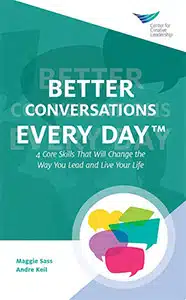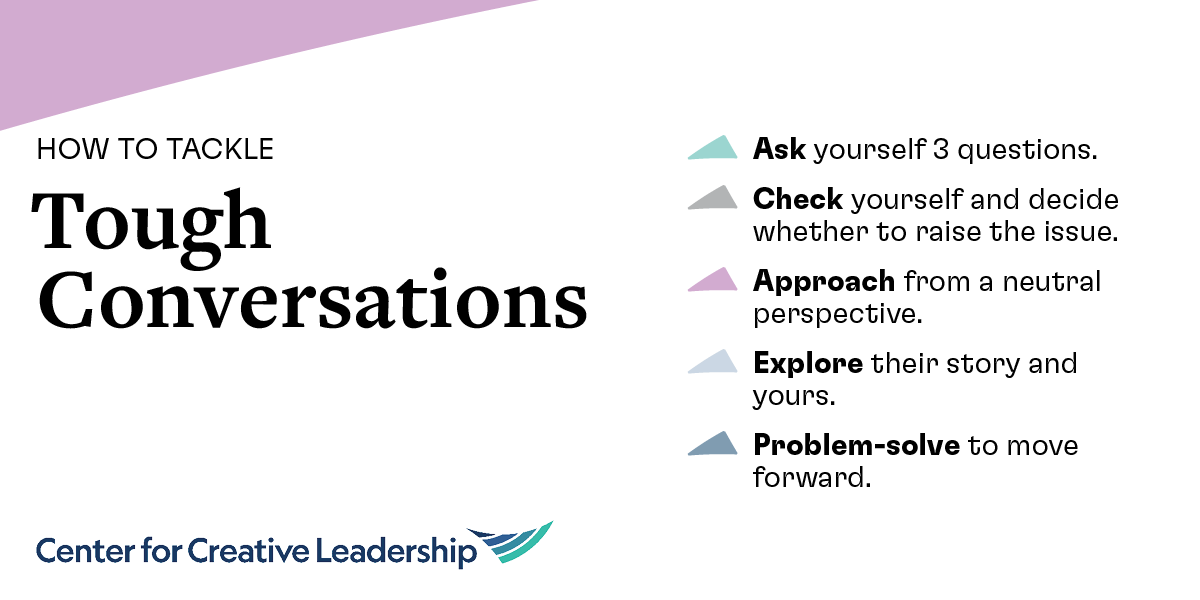Tough challenges aren’t going away. But they’re often very difficult to talk about — leaving us anxious, unsure, frustrated, or angry.
What can be done? In order to deal effectively with awkward, tense, or challenging conversations, we first need to understand the common mistakes we make — and then take steps to tackle the difficult conversation.
Handling Difficult Conversations
According to Difficult Conversations: How to Discuss What Matters Most, we often make 3 major errors in our conversations:
- We assume we already know all we need to know to understand and explain a situation.
- We hide our feelings — or let them loose in ways we later regret.
- We ignore who we are, acting as if our identity is separate from the issues.
Avoiding these mistakes isn’t easy. The key is to shift your thinking from I need to explain myself (or deliver a message) to I need to listen and learn more about what’s going on. The listening is really the critical part.
5 Steps for Leaders
Here’s how to tackle a difficult conversation:
1. Prepare for a difficult conversation by walking through the “3 conversations” ahead of time.
Every difficult conversation is really comprised of 3 conversations in one:
- The what happened conversation
- The feelings conversation
- The identity conversation
So first, understand what the people involved are thinking and feeling, but not saying to each other. In a difficult conversation, this is usually where the real action is. Before stepping into an especially challenging conversation or trying to calm a workplace conflict, ask yourself these questions:
- Sort out what happened. How do you see the situation? Where does your story come from (information, past experiences, rules)? What do you think you know about the other person’s viewpoint? What impact has this situation had on you? What might their intentions have been? What have you each contributed to the problem?
- Understand your feelings. Explore your feelings and ask yourself, What bundle of emotions am I experiencing?
- Ground your identity. How does this situation threaten you or have the potential to shake up your sense of identity? How do you see yourself (I’m the boss; I like competition; I’m loyal; I’m good at developing my people)? What do you need to accept in order to be better grounded?
2. Check your purposes and decide whether to raise the issue.
Make sure you really need to raise the issue at all. Will that help you achieve your purposes? To determine that, ask yourself:
- What do I hope to accomplish by having this conversation?
- Do I want to prove a point or change the other person?
- How can I shift my stance to support learning, sharing, and problem-solving?
- Can I affect the problem by changing my own contributions?
- If I don’t raise it, can I let go of it?
3. Start from the “third story.”
If you do decide to raise a difficult issue, don’t lead in with your view or story. Approach it as if a third, neutral person is looking on and leading the conversation. Describe the problem as the difference between your stories. Include both viewpoints as a legitimate part of the discussion. Share your purposes and let the other person know you’re looking to sort out the situation together.
4. Explore their story and yours.
Actively listen to understand the other person’s perspective on what happened. Ask questions. Acknowledge the feelings behind the arguments and accusations. Paraphrase to see if you’ve got it. Try to unravel how the 2 of you got to this place.
Share your own viewpoint, your past experiences, intentions, and feelings. And constantly reframe assumptions: from truth to perceptions, blame to contribution, and accusations to feelings.
5. Problem-solve.
Invent options that meet each side’s most important concerns and interests. Keep in mind that relationships that always go one way rarely last. Talk about how to keep communication open as you go forward.
Access Our Webinar!
Watch our webinar, How Leaders and Leadership Collectives Can Increase Psychological Safety at Work, and learn how to promote psychological safety to foster trust, creativity, collaboration, and innovation across the organization.
Reduce the Need for a Difficult Conversation: Prevent Conflict in the First Place
Difficult conversations often have to happen because better conversations didn’t.
People need to experience a 4:1 ratio of positive/encouraging interactions to challenging interactions in order to avoid feeling threatened or overly criticized. Increasing the amount of positive feedback and empowering conversations will strengthen engagement, promote psychological safety at work, and help avoid triggering a threat response.
Everyone in your organization can have more productive conversations when they genuinely listen in order to understand, ask the right questions, give feedback that challenges and supports, and establish accountability and next steps. This is a key part of building a better organizational culture through better conversations.

Learn how to communicate better, connect more deeply, build trust, and be more satisfied — inside and outside of work — with our book, Better Conversations Every Day.
With the right training and practice, leaders at any level can improve the quality of their conversations and feedback, creating a ripple effect throughout the workplace.
Ready to Take the Next Step?
Learn how building coaching skills across your organization can enable you and your team to hold difficult conversations with one another more effectively.











